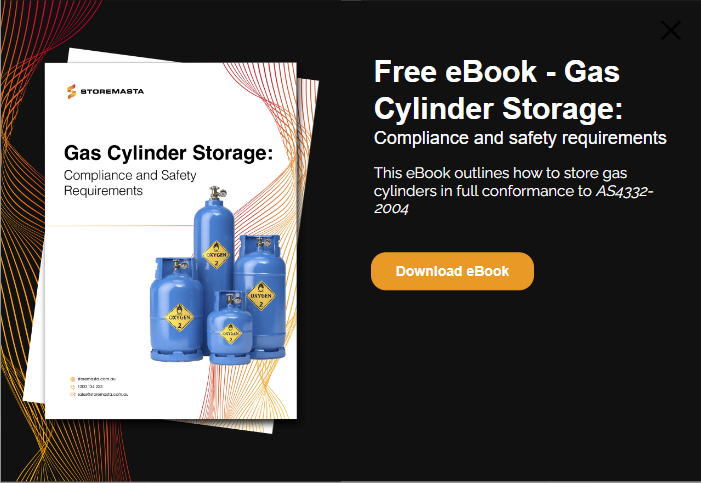How many gas bottles do you handle and store at your worksite? Even worksites with small quantities have obligations under Australian WHS legislation. This blog looks at AS4332-2004 - The storage and handling of gases in cylinders and the criteria for ‘minor storage’ — a classification of worksites that hold smaller quantities of compressed gases, but still have storage and handling obligations.
What is Australian Standard AS4332-2004?
Australian Standard AS4332-2004 sets out the requirements and recommendations for safely storing and handling compressed gases in cylinders. The Standard applies to all locations; but generally they will be industrial, commercial or rural worksites.
The Standard is divided into 8 sections and each section is applied to your workplace based on how many cylinders you hold.
- If your worksite holds a small number of cylinders and is designated as ‘minor storage’, only Sections 1, 2, 5.2-3 and 8 will need to be applied — though the remainder of the Standard should still be consulted for best practices and advisory purposes.
- If the quantity of cylinders at your worksite exceeds ‘minor storage’ limits, then Sections 1, 3-8 must be fully applied to worksites
Only residential premises that store less than 10% of the maximum quantities allowable for ‘minor storage’ are exempt from the requirements of the Standard.
“The Standard applies to gases that are classified as Class 2 substances in the ADG Code (i.e. gases that are compressed, liquefied or dissolved under pressure, including refrigerated liquefied gases, mixtures of one or more gases with vapours or liquids of substances of other classes, articles charged with a gas and aerosols having a capacity of greater than 1 L. “
AS4332-2004 SECTION 1.1 SCOPE
What is ‘minor storage’?
If your workplace holds less than 2,000 litres of gas, you’re classed as ‘minor storage’. The 2,000 litres is the aggregate quantity of all gases held onsite, and if any of the gases exceed the quantities listed below, the worksite is no longer considered ‘minor storage’ and the full standard applies.
- Class 2.1 Flammable Gases - 500 litres
- Class 2.2 Non Toxic Gases - 2,000 litres
- Class 2.1 (5.1) Non Toxic, Oxidising Gases - 1,000 litres
- Class 2.3 Toxic Gases - 50 litres
For example, if your worksite stores 60 litres of Class 2.3 Toxic Gas and no other gases, it is NOT minor storage and the full Standard will apply.
Workplace precautions for storing and handling gases
Even though minor storage may indicate that quantities of gas cylinders are so small, scattered or separated they present little real risk or add to a building’s fire load, there are still storage and handling requirements applicable to your workplace under the Standard. These include:
- Keeping cylinders away from industrial heat like radiators, furnaces, steam pipes and machinery.
- Making sure cylinders do not come within 3 metres of combustibles, vegetation and waste materials or refuse.
- Ventilating the area where cylinders are stored or used so that safe exposure levels are maintained, and the gases remain within explosion limits.
- Any staff, contractors and personnel who use or might come into contact with the gases onsite, must receive adequate training about the chemical hazards and how to keep safe.
- Ideally the cylinders should be stored outside — in a dedicated cylinder store with a flat, concrete base. Cylinders should not be stored in a basement
- Keeping Class 2.1, Class 2.2 (5.1) and Class 2.3 gases segregated from each other (as well as other Dangerous Goods) by at least 3 metres (5 metres if the gases are stored indoors).
- Having a first aid kit and fire protection equipment nearby.
- Protecting large cylinders (‘G’, ‘F’ and ‘E’ sizes) from being accidentally knocked over — gas bottle trolleys and a dedicated cylinder store an ideal solution.
- Using correct manual handling procedures including mechanical lifting devices and gas bottle trolleys.
IMPORTANT: Section 5.3 of the Standard also applies to ‘Minor Storage’. For full details why not download our free eBook Gas Cylinder Storage: Compliance and safety requirements which presents the requirements in easy-to-read text along with real world examples and case studies.
Considerations for retail workplaces
Special considerations apply to workplaces that hold and store gas bottles but are visited by the general public. Some of these requirements include:
- Holding cylinders in back areas and restricting public access.
- Only moving cylinders outside normal trading hours.
- Minimising the quantities of cylinders in use, as well as those on stand-by and empties waiting for removal. Half the ‘minor storage’ quantities should be considered a maximum.
- Transfilling (filling of small cylinders from large cylinders) in areas that cannot be accessed by the public.
- Only holding Class 2.2 (non-flammable, non-toxic) gases with no subsidiary risks in retail areas that are accessed by the public access.
- Making sure the retail areas has adequate fire protection (9 kg dry powder extinguisher provided as a minimum).
Next Steps
If you are a WHS Manager or supervisor responsible for the safe storage and compliance of Dangerous Goods at your worksite, we recommend you download our free eBook Cylinder Storage: Compliance and safety requirements. We outline the requirements AS4332-2004 - The storage and handling of gases in cylinders and introduce a risk management methodology — for safely introducing control measures to minimise the harm associated with compressed gases stored in cylinders. Download it today by clicking on the image below:
Joining the team as a Dangerous Goods Storage Consultant, Melissa Hampton became Storemasta's Marketing Manager in late 2021. With extensive knowledge and experience in chemical compliance, Melissa is responsible for leading the Marketing team and helping shape their marketing strategy. In her spare time, you can find Melissa hiking, swimming and enjoying the great outdoors in beautiful north-west Tasmania.
